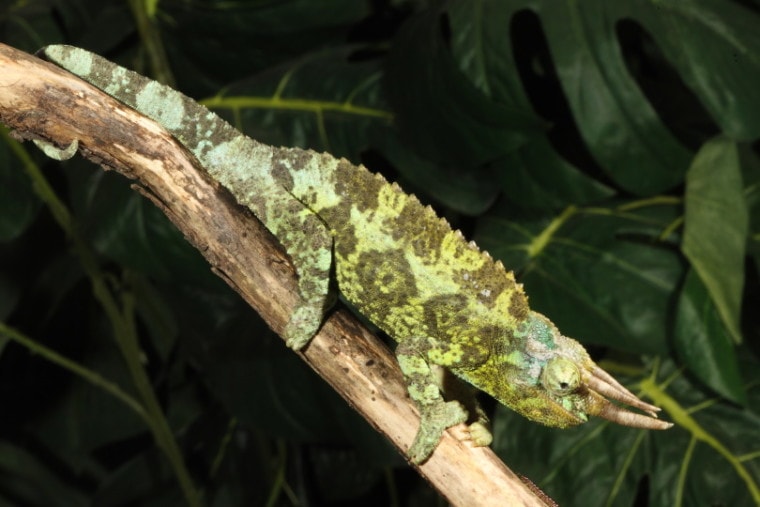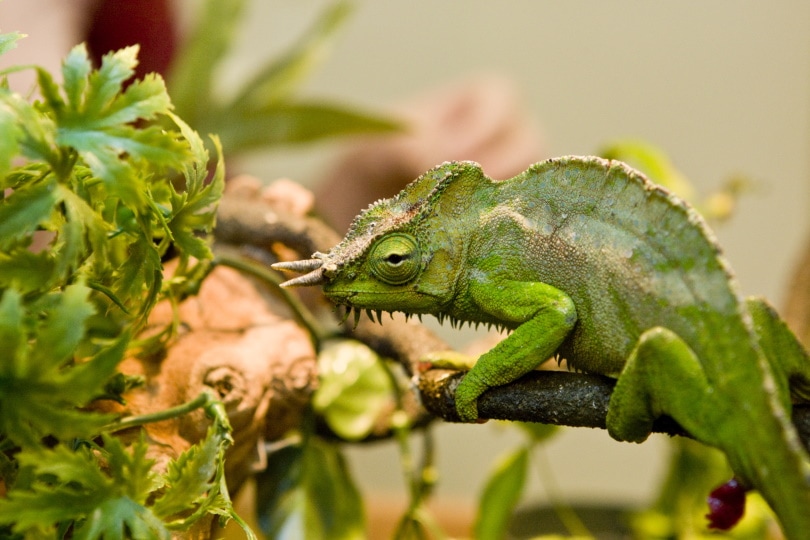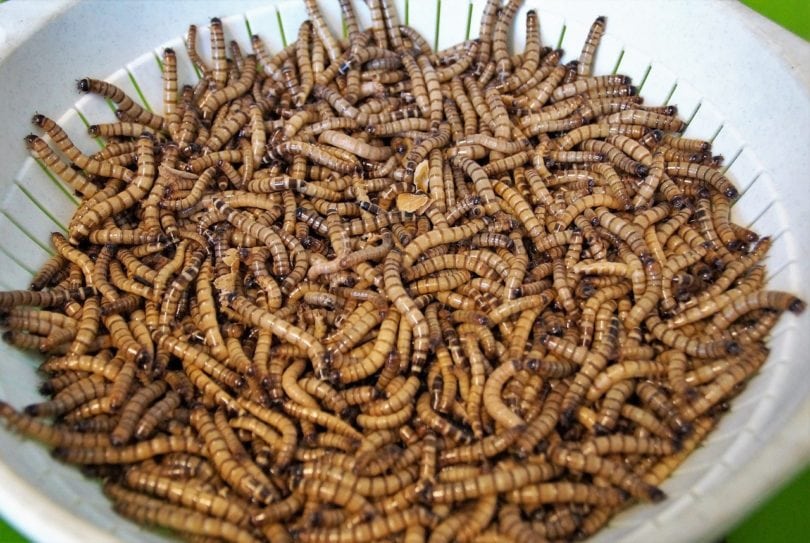
The four-horned chameleon is a medium-sized chameleon that is attractive looking but often considered less colorful than other breeds of chams. The male of the species has between one and six horns in captivity as well as a large sail fin and is best described as multi-colored. The female is not as ornately colored and lacks the large sailfin and crest.
The breed is not considered a starter species and is best left to those who have owned other types of chameleons before. They are best kept alone, though they can be kept as a mating pair if you have a very large enclosure. Unlike a lot of lizards, they require a cool temperature to stay healthy and happy, while also needing humidity levels of 50% or higher.
 Quick Facts about Four-Horned Chameleons
Quick Facts about Four-Horned Chameleons
| Species Name | Trioceros quadricornis |
| Family | Chamaeleonidae |
| Care Level | Moderate |
| Temperature | 55°–75°F |
| Temperament | Sensitive and shy |
| Color Form | Greenish yellow with blue to purple markings |
| Lifespan | 4–7 years |
| Size | 1–14 inches |
| Diet | Live insects |
| Minimum Tank Size | 2’ x 2’ x 4’ |
| Tank Set-Up | Tank, plants, lights, thermometer, humidity gauge |
| Compatibility | Better alone but can live in mating pairs |
Four-Horned Chameleon Overview

The four-horned chameleon comes from Cameroon, Africa. The country is located on the equator and bordered by Nigeria. Specifically, it comes from the Mount Lefo region and it loves humid and cool weather. Its native rainforest receives up to 400 inches of rainfall in a single year, showing how much this breed of sail-fin chameleon enjoys a humid environment.
Unlike many lizards, the four-horned chameleon enjoys cooler temperatures. Rather than trying to heat its enclosure, you are more likely to try and find ways in which to cool it down to the desired 70° F. You will also need to provide a constant level of humidity: a failure to do so can cause dehydration that may eventually lead to kidney failure and other serious illnesses.
It is thanks to these requirements that the four-horned chameleon is usually described as being best for experienced owners and not for novices.
If you do meet the specific requirements of your four-horned chameleon, though, it can be a hardy pet and will reward you.
How Much Do Four-Horned Chameleons Cost?
Expect to pay a minimum of $250 for a good example of this breed. The majority of this breed are wild-caught and imported, with very few being bred in captivity.
If the chameleon is imported, the most important thing is to check for signs of dehydration. The skin should be firm and should not hang loose. It should be alert, rather than drowsy, and it should be able to eat without any problems, although if it is stressed from the journey, it may not be willing to eat straight away. You should also look for signs of parasites, which can be present outside as well as inside the lizard.
Typical Behavior & Temperament
The four-horned chameleon is similar to any cham in that they do not enjoy being handled by humans. Typically, this type of lizard is considered akin to an exotic fish. Its beauty is to be enjoyed and witnessed, but you won’t be able to take it out of its tank for cuddles.
When in its enclosure the cham tends to be quite slow, even a little docile. It will perk up after some time getting used to its surrounding, and you should particularly enjoy watching it eat.
Appearance & Varieties

The quad, as it is often referred to, will range in size up to 14 inches, with males usually being larger than females.
Males have between one and six horns. They also have a large sail fin on the back and the top of the tail. They are usually a green-yellow color and may have a stripe of orange or red down the side. The fin is a blue color, and the overall appearance of the quad is that of a multi-colored chameleon.
The female has a smaller fin and crest and is usually a green color, with fewer color variations and markings.
How to Take Care of Four-Horned Chameleons
Habitat, Tank Conditions & Setup
This is not considered a beginner species, specifically because of the cool temperature and ongoing humidity requirements of the lizard. It requires a lot of work, and it is harder to keep tank temperatures down and humidity levels up than it is to keep temperatures high. No matter how much experience you have keeping chameleons, however, you will need the following setup for your quad.
Tank
The tank itself needs to be a minimum of 2 feet square wide and 3-4 feet high. A glass tank may be beneficial because glass allows heat to escape and if you can give your cham more room than the bare minimum, your captive pet will appreciate it.
Heating
You need to replicate the conditions of the Cameroonian rainforest, where it is cool but rains heavily and all the time. The rainforest can see as much as 400 inches of rain every year. To replicate this, you will need to keep humidity levels high with regular misting and by incorporating a bowl of water in the tank. You will even need to ensure that you keep the tank away from windows because the sun can prove too hot for your cham. Use a thermometer and test different areas in the room or house until you find the ideal spot. The temperature should be around 70° F and the humidity at a constant level of 50%.

Lighting
You should provide a basking light, and the temperature in the basking spot can reach as high as 80° F but you must also ensure that your cham can get away from the basking area when required.
Provide a source of UVB. This will help the cham produce adequate amounts of vitamin D, which also aids in the absorption and use of calcium.
Decorations
This species of cham hails from the rainforest, and it will want a similar setup in its tank to be as happy as possible. Provide plenty of non-toxic plants. These will also provide shade and can help with humidity, especially if you mist them over the day.
Use a substrate that holds moisture because this will help maintain humidity levels. Coco husk and orchid bark are two common examples that have proven successful with cham owners.
Do Four-Horned Chameleons Get Along with Other Pets?
Four-horned chameleons should not be introduced to other animals. It can stress the cham out, and the species is unlikely to bond with any other animal. Furthermore, although it may be possible, with a large and purpose-built enclosure, to keep a mating pair of quads together, it is typically recommended that you only keep one quad per enclosure.
What to Feed Your Four-Horned Chameleon

The quad is a carnivore and will eat any of a wide range of insects. In particular, they enjoy crickets, locusts, and mealworms. They may eat flies and snails, too, and feeder insects should be gut-loaded with nutrients to ensure that the cham is getting its full quota of vitamins and nutrients each day. Supplements usually include vitamin D and calcium and are dusted on insects or fed to them before they are fed to the quad itself. Young quads should be fed daily while adults can be fed two or three times a week.
Keeping Your Four-Horned Chameleon Healthy
The biggest challenge in ensuring that your quad is healthy and happy is temperature. In warm climates, it may be necessary to buy an air conditioning unit to reduce the ambient temperature around the tank. You also need to retain humidity levels at or above 50% or your cham could suffer dehydration, which is fatal.
Remember that chameleons will drink water but they need to see the water move before they will even consider lapping it. Mist leaves so that water drops fall or provide a water fountain to drink from to encourage more drinking and better hydration levels.
When you first get your chameleon, bear in mind that it is a somewhat sensitive species and it will take time to settle in and rehydrate. It may not eat straight away, but as long as you ensure that it is adequately hydrated, it will start to take food in no time.
Breeding
To breed four-horned chameleons you will need a mature pair that are unrelated. Simply place the female in the male’s enclosure and the male will mate. After several weeks, you should notice the female get a little bigger. Provide the gravid female with a viable nesting site, typically a plastic tub, and put plenty of soft soil in that she can burrow into. Expect approximately a dozen eggs per clutch and incubate them at approximately 70° F.
 Are Four-Horned Chameleons Suitable for You?
Are Four-Horned Chameleons Suitable for You?
The four-horned chameleon is not considered a beginner chameleon. It requires lower temperatures and constant humidity, both of which can be difficult to maintain. They eat insects, which should be gut-loaded and will benefit from as much room as you can provide them. They will grow to 14 inches and can be bred in captivity, although most of this type of cham that can be bought as a pet are caught wild and imported.
Featured Image Credit: Dennis W Donohue, Shutterstock
 Quick Facts about Four-Horned Chameleons
Quick Facts about Four-Horned Chameleons






